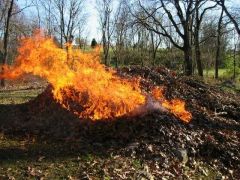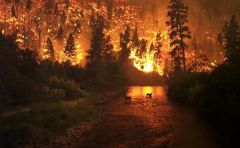![]()
![]()
![]()
Use LEFT and RIGHT arrow keys to navigate between flashcards;
Use UP and DOWN arrow keys to flip the card;
H to show hint;
A reads text to speech;
19 Cards in this Set
- Front
- Back
- 3rd side (hint)
|
The three elements required for a fire to exist are ___________, _________, and __________. These elemts make up the "fire triangle". A base chemical reaction is needed to start the fire if any of these elements is removed, the fire will go out. |
Fuel, Heat and Oxygen |
|
|
|
Different tyoes of fires can occur in a forest. _______________ ____________ is a planned application of fire to natural fuels. When it is confined to a specific area, it can be called ______________ ______________. |
Broadcast Burning and Controlled Burning |
|
|
|
Planning to set the fire when the conditions will create a specific outcome, such as the elimination of a particular type of fuel is called ___________________ ______________. |
Prescribed Burning |
|
|
|
An area with uniform conditions of tree stands and fuel that is treated with one type of burn is a ______________ ____________ |
Burning Block |
|
|
|
A modified form of broadcast burning is ________ __________, where slash is piled into small areas, and only those spots are allowed to burn. |
Spot Burning |

|
|
|
An unplanned and uncontrolled fire is a _________________, which can be started by natural or human means. |
Wildfire |

|
|
|
A fire started unlawfully with the intent to burn properly is an _____________ ________. |
Incendiary Fire |
|
|
|
Fire behavior is influenced by topography, weather, and fuel type; these three factors make up the "fire behavior triangle". Fuel types vary, from grass, leaves, and moss that ignite readily and are consumed rapidly when dry ( ___________ __________), to large wood pieces that burn slowly ( ___________ __________), to foilage, twigs, and small branches that are not contact with the ground (__________ __________). |
Flash Fuels, Heavy Fuels, and Aerial Fuels |
|
|
|
Weather conditions such as wind, temperature, and humidity occur in such combinations at certain yes of the year that make fires likely to occur, spread, and do damage to forest value. This time of the year it is called the ____________ ____________. |
Fire Season |
|
|
|
Within a 24 hour period there are hours (10 am to sundown) when fire spreads most rapidly, a ____________ _____________. |
Burning Period |
|
|
|
Information about weather and fuels can be translated into one number that defines the probable ease of ignition of a fire and its behavior. This number is a ___________ ___________, which can be described in general _________ _____________ categories, such as "severe", or "low". |
Burning Index and Fire Danger |
|
|
|
Fires are not always confined to trees. The uppermost layer of soil and/or surface organic matter ( _____________) can catch on fire, creating a ________________ _________, which can burn unnoticed and even burn under ground, consuming roots as well. |
Litter and Ground Fire |
|
|
|
Sometimes fires get so hot near the ground that the heat alone kills foliage above without any signs of charing or browning. This damage is called __________ ________. |
Heat Kill |
|
|
|
All activities concerned in the protection of a forest from fire is called _________ ____________, and includes prevention, pre-suppression, detection, and suppression. |
Fire Control |
|
|
|
One method of fire detection is to assign a person (a fire _______________) to detect and report forest fires from a vantage point, such as the top of a mountain. |
Lookout |
|
|
|
Fire suppression is the act of controlling a fire once it starts. Any natural or man made barrier to stop the spread of fire is a _______ _______ or ________ ____________. |
Fire Line or Fire Break |
|
|
|
Heavy material can be used to dig down to mineral soil, and can be used as a control line from which fire fighters can work. Often a fire is set against the control line, a _____________, to consume the fuel in the path of a forest fire and/ or to change the direction of the fire. |
Backfire |
|
|
|
The front edge of a fire is the ________, the sides of the fire, roughly parallel to the direction of spread, are the ___________, and the back portion is the _____________. |
Head, Flanks, and Heel |
|
|
|
________________ ______ after a fire involves making a fire safrme after it has been controlled, and can include extinguishing or removing burning material along or near the control line, feeling snags, or digging trenches to prevent logs from rolling out of the burned area. |
Mopping Up |
|

